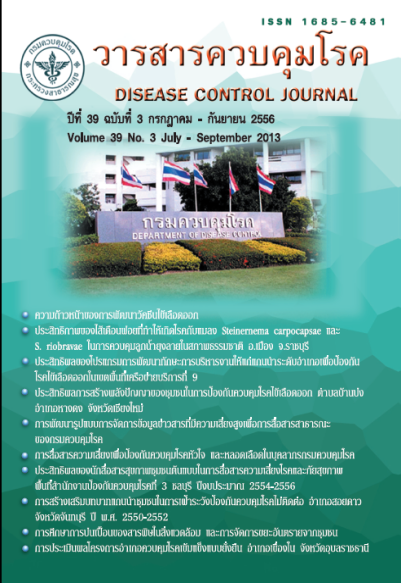The efficiency of entomopathogenic nematodes, Steinernema carpocapsae and S. riobravae for controlling Aedes aegypti larvae in natural condition, Muang District, Ratchaburi Province
DOI:
https://doi.org/10.14456/dcj.2013.11Keywords:
The Efficiency, Entomopathogenic Nematodes, Controlling Aedes aegypti Larvae and CompliancesAbstract
This research aims to study the efficiency of the two selected entomopathogenic nematodes which showed a good efficacy in killing Aedes aegypti larvae in the laboratory, that are Steinernema carpocapsae and S. riobravae. The research consisted of the study on effectiveness of nematodes in the natural condition, the cost comparison between using the nematodes and temephos sand granules to control larvae, evaluate the difficulty and the public acceptance of using the nematodes. The study was conducted at Nongsara community, Moo 9, Pongsawai subdistrict, Muang district, Ratchaburi province. The effectiveness study was done in the water containers outside the house which are the importance sources of mosquito breeding. The study was conducted by selecting only water containers that found larvae, then put nematodes amount 10,000 per 200 sq.cm. and followed up the results from the first day to the fifth day. The cost comparison between using nematodes and temephos sand granules, calculates from the number of nematodes per one container multiply by cost of nematode then compare with cost of using temephos sand granules. The difficulty evaluation of using nematodes was considered from the providing, procedure and frequency of repeat procedure. Data was analyzed from this experiment and literature review. The public acceptance of using nematodes was done by interview volunteers using questionnaires which were developed during the study. The results showed that the effectiveness of nematodes on killing effect of larvae of S. carpocapsae, S. riobravae and the control are 68.00, 46.67, and 0.33 respectively. Both species had peak period on killing effect on larvae at 48 hours and remark decreased at the day 5. The cost of using nematodes was higher than using temephos sand granule about 80 times. For difficulty of using nematodes found that this method is difficult implement because of the few suppliers, complicated procedure that general population cannot self-manage and it need to repeat procedure every 5 days. For public acceptance, it was found that the majority of people (>70%) accepted this measure. In summary, the using of nematodes can be an alternative method for larvae control, but should use S. carpocapsae as the first choice because of its high effectiveness. However this method is not suitable for the national program in controlling Ae. Aegypti larvae due to low effectiveness at 70%, high cost, and complicated procedure.
Downloads
References
2. Guha-Sapir D, Schimmer B. Dengue fever: new paradigms for a changing epidemiology. Emerg Themes Epidemiol 2005: 2(1):1.
3. Guzman MG, Kouri G. Dengue: an update. The Lancet Infectious Diseases 2002; 2(1): 33-42.
4. Spiegel J, Bennett S. Barriers and Bridges to Prevention and Control of Dengue: The Need for a Social-Ecological Approach. EcoHealth
2005; 2: 273-90.
5. Chua KB, Chua IL, Chua IE, Chua KH. Effect of chemical fogging on immature Aedes mosquitoes in natural field conditions. Singapore Med J 2005; 46(11): 639-44.
6. Ponlawat A, Scott JG, Harrington LC. Insecticide susceptibility of Aedes aegypti and Aedesalbopictus across Thailand. J Med Entomol
2005; 42(5): 821-25.
7. Chakravarit A, Kumari R. Eco-epidemiological analysis or gangue infection during an outbreak of dengue fever, India. Virol J 2005; 2: 32.
8. มานิตย์ นาคสุวรรณ. การควบคุมลูกน้ำยุงพาหะนำโรคโดยใช้ไส้เดือนฝอย. วารสารควบคุมโรค 2547; 30: 158-66.
9. วัชรี สมสุข. ไส้เดือนฝอยควบคุมแมลงศัตรูพืช.เอกสารวิชาการควบคุมแมลงศัตรูพืชโดยชีววิธี.กรุงเทพ: กองกีฏและสัตววิทยา กรมวิชาการเกษตร 2534. น. 182-97.
10. Gaugler R, Kaya HK. Entomopathogenic nematodes in biological control. Boca Raton, Florida: CRC Press; 1990: 365.
11. วิไลวรรณ เวชยันต์. การศึกษาการทำให้เกิดโรคของไส้เดือนฝอย Steinernema carpocapsae Weiser ในปลวกงาน Odontotermes feae Wassman. วิทยานิพนธ์ ปริญญาวิทยาศาสตรมหาบัณฑิต สาขากีฏวิทยา บัณฑิตวิทยาลัย มหาวิทยาลัยขอนแก่น. 2544: 65.
12. สำนักงานควบคุมโรคไข้เลือดออก. โรคไข้เลือด-ออกฉบับประเกียรณก. กรุงเทพ: โรงพิมพ์สหกรณ์การเกษตรแห่งประเทศไทย; 2545: 95.
13. Akhurst RJ, Boemare NE. Biology and taxonomy of Xenorhabdus. In: Gaugler R, Haya HK, eds. 1990. Entomopathogenic nematodes in biological control. Boca Raton, Florida: CRC Press; 1990. pp 75-90.
14. สีวิกา แสงธาราทิพย์. ลึกแต่ไม่ลับ ตอนที่ 5 กินอย่างมีศิลปะ. จุลสารไข้เลือดออก 2542; 1(7): 6.
15. Begley JW. Efficacy against in habitats other than soil. In: Gaugler R, Kaya HK, eds. Entomopathogenic nematodes in biological control.
Boca Raton, Florida: CRC Press; 1990: 215-31.
16. Welch HE, Bronskill JF. Parasitism of mosquitolarvae by the nematode, DD-136 (Nematoda:Neoaplectanidae). Can J Zool 40; 1962: 1263-7.
17. Poinar GO. Nematodes for biological control.Boca Raton, Florida: CRC Press; 1979: 143
Downloads
Published
How to Cite
Issue
Section
License
Articles published in the Disease Control Journal are considered as academic work, research or analysis of the personal opinion of the authors, not the opinion of the Thailand Department of Disease Control or editorial team. The authors must be responsible for their articles.






